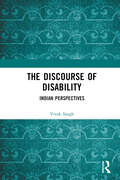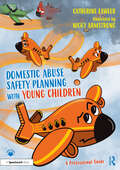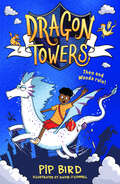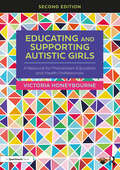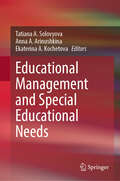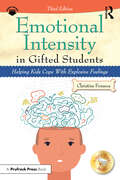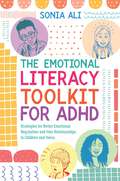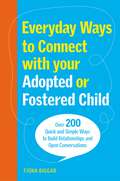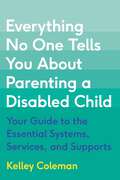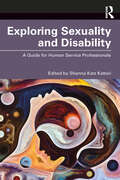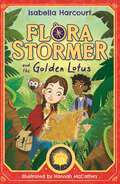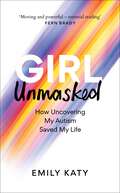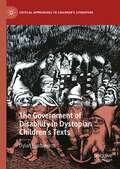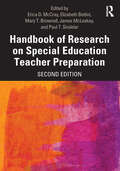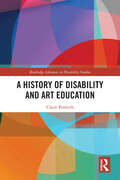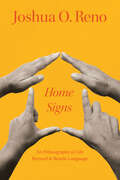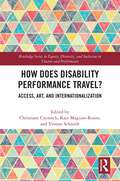- Table View
- List View
The Discourse of Disability: Indian Perspectives
by Vivek SinghThis book explores the concept of disability through a social, political, cultural, religious, and economics lens. It challenges the categorization of ‘physically-disabled’ produced by way of legal, medical, political, cultural, and literary narratives that comprise an exclusionary discourse.The volume discusses themes like disability and identity politics; disability and the western epistemology; disability in India; disability and the Indian English fiction and Hindi cinema to question the embodied hegemony of ‘norms’ and their effects in the construction and history of societies. It analyses select literary and cinematic texts like Trying to Grow, Fireproof, and Animal’s People; and movies, Black and Lafangey Parindey to critically examine the representation of disabled people as freak, monstrous and animal. The book also makes policy recommendations for inclusive education and work norms for disabled people.This book will be beneficial for scholars and researchers of disability studies, cultural studies, film studies, and English literature.
Domestic Abuse Safety Planning with Young Children: A Professional Guide (Safety Planning with Young Children)
by Catherine LawlerThis guidebook is an essential companion to the Pilgrim’s Bumpy Flight story and is designed to be read by professionals to ensure the effective and safe use of the storybook. Pilgrims Bumpy Flight has been created to help young children aged 5–7 experiencing domestic abuse, to explore the concepts of physical and emotional safety. Safety planning with a child offers a way to help them vocalise their feelings and understand what to do when something does not feel right. The professional guide will help supporting adults facilitate safety planning that is experienced as emphatically curious, safe and where the child’s opinion matters. It provides up-to-date information on domestic abuse, childhood trauma, practice tips and how to complete a safety plan with a young child using the storybook as the key vessel of communication and exploration. Key features include: • Accessible information about domestic abuse and coercive control based on the latest research. • Guidance around direct work and safety planning with young children. • Practical activities building off Pilgrim’s story, including printable material. • Things to consider and ways to use the storybook to facilitate a conversation with a child, as well as page-by-page helpers notes on the narrative. • A comprehensive list of helplines and organisations in place to support adult victims/survivors of domestic abuse. Used alongside the storybook, this professional guide is a crucial tool for the early years sector, education staff and those working in children’s services, including safeguarding officers, family support workers, social workers and children’s IDVAs. Both books should be used in tandem with agency policy, procedure and guidance.
Domestic Abuse Safety Planning with Young Children: A Professional Guide (Safety Planning with Young Children)
by Catherine LawlerThis guidebook is an essential companion to the Pilgrim’s Bumpy Flight story and is designed to be read by professionals to ensure the effective and safe use of the storybook. Pilgrims Bumpy Flight has been created to help young children aged 5–7 experiencing domestic abuse, to explore the concepts of physical and emotional safety. Safety planning with a child offers a way to help them vocalise their feelings and understand what to do when something does not feel right. The professional guide will help supporting adults facilitate safety planning that is experienced as emphatically curious, safe and where the child’s opinion matters. It provides up-to-date information on domestic abuse, childhood trauma, practice tips and how to complete a safety plan with a young child using the storybook as the key vessel of communication and exploration. Key features include: • Accessible information about domestic abuse and coercive control based on the latest research. • Guidance around direct work and safety planning with young children. • Practical activities building off Pilgrim’s story, including printable material. • Things to consider and ways to use the storybook to facilitate a conversation with a child, as well as page-by-page helpers notes on the narrative. • A comprehensive list of helplines and organisations in place to support adult victims/survivors of domestic abuse. Used alongside the storybook, this professional guide is a crucial tool for the early years sector, education staff and those working in children’s services, including safeguarding officers, family support workers, social workers and children’s IDVAs. Both books should be used in tandem with agency policy, procedure and guidance.
Dragon Towers (Dragon Towers)
by Pip BirdTake to the skies and join Dragon Towers – the school where everyone has their own dragon best friend! A hilarious new series from the author of the Naughtiest Unicorn – highly illustrated, full of fun and adventure, and starring a dragon with a magical bum. Perfect for readers aged 6 and up.
Ebook: Special Educational Needs, Inclusion and Diversity, 4e
by DunsmuirA textbook on special educational needs which offers a balance between theory, research and practice as well as a unique analysis of the implications of the effects of linguistic, cultural and ethnic diversity on special educational needs. The fourth edition of this textbook will be revised and updated in order to respond to changes in the field, including developments in national policy and in ways of thinking about special educational needs and inclusion. It will take account of research and publications that have appeared since 2014, in particular in the international literature. There will be more on the theoretical aspects of inclusive practice and some of the case studies and learning activities will be updated to make them as relevant as possible, reflecting contemporary examples of best practice in the field. In addition to the central cross-cutting theme (equality, diversity and inclusion), other themes incorporated across chapters will include professional ethics, parental support for learning, person-centred practices and the effects of poverty.
Educating and Supporting Autistic Girls: A Resource for Mainstream Education and Health Professionals
by Victoria HoneybourneAutistic girls, especially those educated in mainstream environments, have often been missed or misdiagnosed. There is now, however, greater awareness of how autism can present in females, why these girls can remain ‘invisible’, and what education and health professionals can do to provide better support. Fully revised and updated, this practical book shines a light on the insights, opinions and experiences of autistic girls and women, providing a rich insight into school life from an autistic perspective. It explores the difficulties and disadvantages that autistic girls can face in educational settings and offers guidance on how to best support them, with a wealth of strategies reflecting good practice in the field of autism and education. The resource also contains a broad range of worksheets and activities on key issues and includes new sections on anxiety, masking, home life, social media, gender and sexual identity. Key features include: A wealth of case studies to illustrate different topics Guidance on best practice when working with autistic girls New audits to help staff and pupils to identify strengths and areas to improve Easy-to-implement strategies and tips to help professionals adapt to environments and policies for autistic students Activities and resources for young autistic females to support them in developing self-awareness, coping strategies and learning skills With the voices of autistic girls and young women woven throughout, drawing upon their experiences of education – from learning and communication, to friendships, transitions and interpreting the world – this is an essential resource for education and health professionals working with autistic girls, particularly in mainstream environments.
Educating and Supporting Autistic Girls: A Resource for Mainstream Education and Health Professionals
by Victoria HoneybourneAutistic girls, especially those educated in mainstream environments, have often been missed or misdiagnosed. There is now, however, greater awareness of how autism can present in females, why these girls can remain ‘invisible’, and what education and health professionals can do to provide better support. Fully revised and updated, this practical book shines a light on the insights, opinions and experiences of autistic girls and women, providing a rich insight into school life from an autistic perspective. It explores the difficulties and disadvantages that autistic girls can face in educational settings and offers guidance on how to best support them, with a wealth of strategies reflecting good practice in the field of autism and education. The resource also contains a broad range of worksheets and activities on key issues and includes new sections on anxiety, masking, home life, social media, gender and sexual identity. Key features include: A wealth of case studies to illustrate different topics Guidance on best practice when working with autistic girls New audits to help staff and pupils to identify strengths and areas to improve Easy-to-implement strategies and tips to help professionals adapt to environments and policies for autistic students Activities and resources for young autistic females to support them in developing self-awareness, coping strategies and learning skills With the voices of autistic girls and young women woven throughout, drawing upon their experiences of education – from learning and communication, to friendships, transitions and interpreting the world – this is an essential resource for education and health professionals working with autistic girls, particularly in mainstream environments.
Educational Management and Special Educational Needs
by Tatiana A. Solovyova Anna A. Arinushkina Ekaterina A. KochetovaThis book systematizes the latest findings on the clinical, psychological, and pedagogical features of today’s children with special educational needs (SEN) and expands the scientific understanding that characterizes such children. The book develops a system of education and assistance for children with SEN, including children with locomotor disabilities, intellectual disabilities, autism spectrum disorders, and hearing and visual impairments. The book is intended for heads of educational authorities, parents, specialists working with children with special educational needs, psychologists, teachers, methodologists, specialists in the field of inclusive education, and students and teachers in special education of pedagogical and psychological departments of higher education institutions.
Emotional Intensity in Gifted Students: Helping Kids Cope With Explosive Feelings
by Christine FonsecaTeaching children how to manage their intense emotions is one of the most difficult aspects of parenting or educating gifted children. Emotional Intensity in Gifted Students is an indispensable resource for parents and educators seeking to understand why gifted children can be so extreme in their behavior and how to manage the highs and lows that accompany emotional intensity. Presented in an easy-to-read, conversational style, this revised and updated third edition pulls from contemporary research to depict changes in how we understand and support gifted children as well as an increased understanding of trauma, social-emotional learning, and empathy development. Chapters feature role-plays and strategies designed to show parents and teachers how to interact and guide gifted children in a way that teaches them how to recognize, monitor, and adjust their behavior. Also featuring updated resources, worksheets, and checklists, this practical new edition is a must-read for anyone wishing to make a positive and lasting impact on the lives of gifted children.
Emotional Intensity in Gifted Students: Helping Kids Cope With Explosive Feelings
by Christine FonsecaTeaching children how to manage their intense emotions is one of the most difficult aspects of parenting or educating gifted children. Emotional Intensity in Gifted Students is an indispensable resource for parents and educators seeking to understand why gifted children can be so extreme in their behavior and how to manage the highs and lows that accompany emotional intensity. Presented in an easy-to-read, conversational style, this revised and updated third edition pulls from contemporary research to depict changes in how we understand and support gifted children as well as an increased understanding of trauma, social-emotional learning, and empathy development. Chapters feature role-plays and strategies designed to show parents and teachers how to interact and guide gifted children in a way that teaches them how to recognize, monitor, and adjust their behavior. Also featuring updated resources, worksheets, and checklists, this practical new edition is a must-read for anyone wishing to make a positive and lasting impact on the lives of gifted children.
The Emotional Literacy Toolkit for ADHD: Strategies for Better Emotional Regulation and Peer Relationships in Children and Teens
by Sonia AliChallenges with emotional regulation and rejection sensitivity can disproportionately affect children and teens with ADHD, impacting on their development at school and their relationship with their peers.Developed for children and young people who experience difficulties with emotional regulation, SEND specialist Sonia Ali, shares a mentoring Intervention programme to support a child or young person with this issue at school or at home. Covering concepts like the fight, flight or freeze response and the 'Window of Tolerance', managing anger outbursts and overwhelm or navigating conflict with peers, this easily digestible book will help educators and carers support children and teens to develop core emotional literacy skills in an enjoyable way!This accessible, step-by-step guide is packed with activities, including role-play situations, discussion-based statements, quizzes and more. The programme can be followed sequentially or 'dipped into' to support a child with a particular issue when relevant.
Everyday Ways to Connect with Your Adopted or Fostered Child: Over 200 Quick and Simple Ways to Build Relationships and Open Conversations
by Fiona BiggarThis indispensable guide has over 200 simple, easy to implement therapeutic parenting activities which you can easily build into everyday life. Starting with a simple explanation of therapeutic parenting and how to do it, it provides a host of strategies and activities to help tackle common challenges faced by families affected by trauma. This includes improving communication and relationships, lessening conflict, building confidence, creating structure and routine, and handling big emotions. The activities range from short daily check-ins to reinforce attachment through to creative therapeutic activities. The ideas in this book will help create an environment of acceptance, safety, and respect, and enable you and your child to build a stronger, more connected relationship.
Everything No One Tells You About Parenting a Disabled Child: Your Guide to the Essential Systems, Services, and Supports
by Kelley ColemanThe honest, relatable, actionable roadmap to the practicalities of parenting a disabled child, featuring personal stories, expert interviews, and the foundational information parents need to know about topics including diagnosis, school, doctors, insurance, financial planning, disability rights, and what life looks like as a parent caregiver. For parents of disabled children, navigating the systems, services, and supports is a daunting, and often overwhelming, task. No one explains to parents how to figure out the complex medical, educational, and social service systems essential to their child&’s success. Over and over, parents are being asked to reinvent the exact same wheels. According to the CDC, &“Every 4 ½ minutes a baby is born with a birth defect in the United States.&” That&’s 1 in 33. There&’s no handbook for how to do this. Until now. Presented with empathy and humor, Everything No One Tells You About Parenting a Disabled Child: Your Guide to the Essential Systems, Services, and Supports gives parents the tools to conquer the stuff, so that they can spend less time filling out forms, and more time loving their children exactly as they are. With over a decade of experience navigating these systems for her own child, author Kelley Coleman presents key information, templates, and wisdom alongside practical advice from over 40 experts, covering topics such as diagnosis, working with your medical team, insurance, financial planning, disability rights and advocacy, and individualized education plans. Everything No One Tells You About Parenting a Disabled Child gives parents the tools they need to stop wasting unnecessary time, money, and stress. If you need to know how to actually do the things, this book is for you.
Exploring Sexuality and Disability: A Guide for Human Service Professionals
by Shanna Katz KattariOffering a current, comprehensive, and intersectional guide for students, practitioners, and researchers, this book synthesizes existing scholarship on culturally responsive practices that assist in exploring, understanding, and affirming the sexuality(ies) of disabled, chronically ill, neurodivergent, and Mad individuals. Drawing on an intersectional framework, it integrates insights drawn from an interdisciplinary body of scholarship including psychology, social work, sociology, history, political science, women and gender studies, cultural studies, and education along with perspectives from the practitioners who are actively defining the next generation of best practices. By highlighting the incredible resilience and resistance of disabled individuals’ and communities’ sexuality and sexual well-being, this book challenges narratives that rely primarily on a one-dimensional view derived from the medical model and the view of disability as something to be “fixed” – or at least tolerated – rather than celebrated. In a world that pathologizes and devalues the sexual existence of disabled individuals, it illustrates how to create thriving communities and relationships, and how they can organize to find their voice, providing a counter-narrative of empowerment that fosters hopefulness, power, and health. It will be of interest to all scholars, students, and professionals across a variety of professions, including social work, psychology, counseling, policy, healthcare, education, community organizing, and multiple social service settings.
Exploring Sexuality and Disability: A Guide for Human Service Professionals
by Shanna Katz KattariOffering a current, comprehensive, and intersectional guide for students, practitioners, and researchers, this book synthesizes existing scholarship on culturally responsive practices that assist in exploring, understanding, and affirming the sexuality(ies) of disabled, chronically ill, neurodivergent, and Mad individuals. Drawing on an intersectional framework, it integrates insights drawn from an interdisciplinary body of scholarship including psychology, social work, sociology, history, political science, women and gender studies, cultural studies, and education along with perspectives from the practitioners who are actively defining the next generation of best practices. By highlighting the incredible resilience and resistance of disabled individuals’ and communities’ sexuality and sexual well-being, this book challenges narratives that rely primarily on a one-dimensional view derived from the medical model and the view of disability as something to be “fixed” – or at least tolerated – rather than celebrated. In a world that pathologizes and devalues the sexual existence of disabled individuals, it illustrates how to create thriving communities and relationships, and how they can organize to find their voice, providing a counter-narrative of empowerment that fosters hopefulness, power, and health. It will be of interest to all scholars, students, and professionals across a variety of professions, including social work, psychology, counseling, policy, healthcare, education, community organizing, and multiple social service settings.
Flora Stormer and the Golden Lotus: Book 1 (Flora Stormer #1)
by Isabella HarcourtFlora Stormer sets off to discover a magical flower hidden deep in the rainforest - and ends up finding . . . HERSELF! A brand-new series combining the magic and adventure of Jumanji with a message celebrating difference and self-acceptance. Flora Stormer, a talented young artist with Tourette's Syndrome, is helping her father prepare for an expedition to search for the legendary golden lotus - a plant with magical healing properties. But when her dad falls ill, Flora bravely sets sail in his place, hoping the mythical plant might save him. Equipped with her paints and a magical map, Flora treks through the rainforest, encountering dangerous animals and poisonous plants along the way. But the greatest threat she faces is from a greedy collector determined get his hands on the flower first. Can Flora and her new friends stop him from stealing the golden lotus and cursing the rainforest forever?Praise for Flora Stormer and the Golden Lotus: "A fun, pacy story with a delightful heroine and a powerful message," Cath Howe, author of Ella on the Outside."There's a little bit of magic and a whole lot of heart in Flora's inspiring adventure!" Lucy Strange, author of Our Castle by the Sea.
Girl Unmasked: How Uncovering My Autism Saved My Life
by Emily Katy'Emily's moving book is a powerful testimony that shines a light on the continued failure of health services to provide any kind of meaningful improvement for autistic people. Should be essential reading for mental health professionals and anyone with autism in their lives.' - FERN BRADY, author of Strong Female Character 'This book will bring so many readers self-recognition and comfort.' - DEVON PRICE, author of Unmasking Autism'Vulnerable, affecting and deeply personal, this book will go from a message in a bottle to a rallying cry for many autistic women, girls and young people. We are not alone.' - Elle McNicoll, bestselling author'A brilliant, thorough exploration of autistic experience, delivered with humanity, compassion and vivid clarity.' - Pete Wharmby, author of Untypical'A magnificent read which manages to be informative, engaging, sad and uplifting all at the same time. Whether you're discovering that you're autistic yourself or you simply want to understand autistic people better, this is a must-read.' - Cathy Wassell, CEO Autistic Girls Network charity & author of Nurturing Your Autistic Young Person'The book I wish I'd been able to read when I was younger.' - Sarah Gibbs, author of Drama QueenTo the outside world, Emily looks like a typical girl, with a normal family, living an ordinary life. But inside, Emily does not feel typical, and the older she gets, the more she realises that she is different.As she finally discovers when she is 16, Emily is autistic. Girl Unmasked is the extraordinary story of how she got there - and how she very nearly didn't. Still only 21, Emily writes with startling candour about the years leading up to her diagnosis. How books and imagination became her refuge as she sought to escape the increasing anxiety and unbearable stresses of school life; how her OCD almost destroyed her; how a system which did not understand autism let her down; and how she came so close to the edge that she and her family thought she would never survive.In this simple but powerful memoir, we see how family and friends became her lifeline and how, post-diagnosis, Emily came to understand her authentic self and begin to turn her life around, eventually becoming a mental health nurse with a desire to help others where she herself had once been failed.Ultimately uplifting, Girl Unmasked is a remarkable insight into what it can be like to be autistic - and shows us that through understanding and embracing difference we can all find ways to thrive.
The Government of Disability in Dystopian Children’s Texts (Critical Approaches to Children's Literature)
by Dylan HoldsworthThis book takes up the task of mapping discursive shifts in the representation of disability in dystopian youth texts across four historical periods where major social, cultural and political shifts were occurring in the lives of many disabled people. By focusing on dystopian texts, which the author argues act as sites for challenging or reinforcing dominant belief systems and ways of being, this study explores the potential of literature, film and television to act as a catalyst of change in the representation of disability. In addition, this work discusses the texts and technologies that continue to perpetuate questionable and often competing discourses on the subject.
Handbook of Research on Special Education Teacher Preparation
by Erica D. McCray Elizabeth Bettini Mary T. Brownell James McLeskey Paul T. SindelarThe new edition of this landmark text expands our current understanding of teacher education broadly by providing an in-depth look at the most up-to-date research on special education teacher preparation. Offering a comprehensive review of research on attracting, preparing, and sustaining personnel to effectively serve students with disabilities, it is fully updated to align with current knowledge and future perspectives on special educator development, synthesizing what we can do to continue advancing as a field. The Handbook of Research on Special Education Teacher Preparation is a great resource not only to special education faculty and the doctoral students they prepare, but also to scholars outside of special education who address questions related to special education teacher supply, demand, and attrition.
Handbook of Research on Special Education Teacher Preparation
by Erica D. McCray Elizabeth Bettini Mary T. Brownell James McLeskey Paul T. SindelarThe new edition of this landmark text expands our current understanding of teacher education broadly by providing an in-depth look at the most up-to-date research on special education teacher preparation. Offering a comprehensive review of research on attracting, preparing, and sustaining personnel to effectively serve students with disabilities, it is fully updated to align with current knowledge and future perspectives on special educator development, synthesizing what we can do to continue advancing as a field. The Handbook of Research on Special Education Teacher Preparation is a great resource not only to special education faculty and the doctoral students they prepare, but also to scholars outside of special education who address questions related to special education teacher supply, demand, and attrition.
A History of Disability and Art Education (Routledge Advances in Disability Studies)
by Claire PenkethDrawing on recent theoretical frameworks from critical disability studies and art education including normalcy, ableism, disability and Crip theory, this book offers an analysis of the conceptualisation of ability in art education and its relationship with disability. Drawing on the work of Cizek and Lowenfeld in Austria, Ruskin and Richardson in England and Dewey and Eisner in the United States, it critically examines the influence of ideas such as the dominance of vision and visuality; the emergence of psychological perspectives; the Child Art Movement; the implications of assessment regimes; and the relevance of art education as a critical social practice on the production of disability. Offering a sustained inquiry into the differential values attributed to learners and their work and the implications of this for framing our understanding of disability in art education, this book shows that although art educators have frequently advocated for the universal appeal and importance of art education, they have done so within historical contexts that have produced and determined problematic ideas regarding disability. It will be of interest to all scholars and students of disability studies, art in education, art history and education studies.
A History of Disability and Art Education (Routledge Advances in Disability Studies)
by Claire PenkethDrawing on recent theoretical frameworks from critical disability studies and art education including normalcy, ableism, disability and Crip theory, this book offers an analysis of the conceptualisation of ability in art education and its relationship with disability. Drawing on the work of Cizek and Lowenfeld in Austria, Ruskin and Richardson in England and Dewey and Eisner in the United States, it critically examines the influence of ideas such as the dominance of vision and visuality; the emergence of psychological perspectives; the Child Art Movement; the implications of assessment regimes; and the relevance of art education as a critical social practice on the production of disability. Offering a sustained inquiry into the differential values attributed to learners and their work and the implications of this for framing our understanding of disability in art education, this book shows that although art educators have frequently advocated for the universal appeal and importance of art education, they have done so within historical contexts that have produced and determined problematic ideas regarding disability. It will be of interest to all scholars and students of disability studies, art in education, art history and education studies.
Home Signs: An Ethnography of Life beyond and beside Language
by Joshua O. RenoAn intimate account of an anthropologist’s relationship with his non-verbal son and how it has shaped and transformed his understanding of closeness and communication. Home Signs grew out of the anthropologist Joshua Reno’s experience of caring for and trying to communicate with his teenage son, Charlie, who cannot speak. To manage interactions with others, Charlie uses what are known as “home signs,” gestures developed to meet his need for expression, ranging from the wiggle of a finger to a subtle sideways glance. Though he is nonverbal, he is far from silent: in fact, he is in constant communication with others. In this intimate reflection on language, disability, and togetherness, the author invites us into his and Charlie’s shared world. Combining portraits of family life and interviews with other caregivers, Reno upends several assumptions, especially the idea that people who seem not to be able to speak for themselves need others to speak on their behalf. With its broad exploration of nonverbal communication in both human and nonhuman contexts, Home Signs challenges us to think harder about what it means to lead a “normal” life and to connect with another person.
How Does Disability Performance Travel?: Access, Art, and Internationalization (Routledge Series in Equity, Diversity, and Inclusion in Theatre and Performance)
by Christiane Czymoch Kate Maguire-Rosier Yvonne SchmidtThis edited collection investigates the myriad ways in which disability performance travels in a globalized world. Disability arts festivals are growing in different parts of the world; theatre and dance companies with disabled artists are increasingly touring and collaborating with international partners. At the same time, theatre spaces are often not accessible, and the necessity of mobility excludes some disabled artists from being part of an international disability arts community. How does disability performance travel, who does not travel – and why? What is the role of funding and producing structures, disability arts festivals and networks around the world? How do the logics of international (co-)producing govern the way in which disability art is represented internationally? Who is excluded from being part of a touring theatre or dance company, and how can festivals, conferences, and other agents of a growing disability culture create other forms of participation, which are not limited to physical co-presence? This study will contextualize disability aesthetics, arts, media, and culture in a global frame, yet firmly rooted in its smaller national, state, and local community settings and will be of great interest to students and scholars in the field.
How Does Disability Performance Travel?: Access, Art, and Internationalization (Routledge Series in Equity, Diversity, and Inclusion in Theatre and Performance)
This edited collection investigates the myriad ways in which disability performance travels in a globalized world. Disability arts festivals are growing in different parts of the world; theatre and dance companies with disabled artists are increasingly touring and collaborating with international partners. At the same time, theatre spaces are often not accessible, and the necessity of mobility excludes some disabled artists from being part of an international disability arts community. How does disability performance travel, who does not travel – and why? What is the role of funding and producing structures, disability arts festivals and networks around the world? How do the logics of international (co-)producing govern the way in which disability art is represented internationally? Who is excluded from being part of a touring theatre or dance company, and how can festivals, conferences, and other agents of a growing disability culture create other forms of participation, which are not limited to physical co-presence? This study will contextualize disability aesthetics, arts, media, and culture in a global frame, yet firmly rooted in its smaller national, state, and local community settings and will be of great interest to students and scholars in the field.
